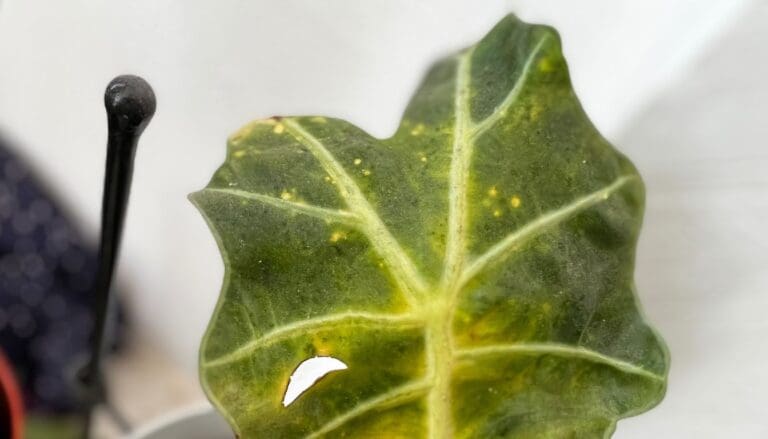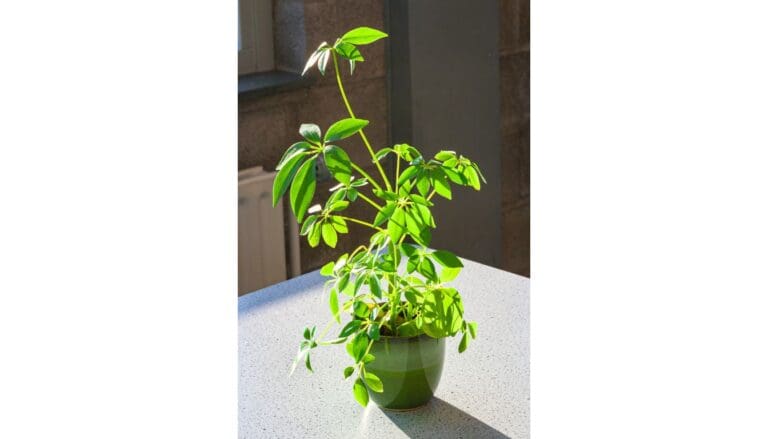10 Tips to Make a Jade Plant Bloom
Many plant lovers grow jade plants for their thick, glossy leaves and tree-like appearance. These beautiful succulents make great houseplants, and I’ve found they can live for many years with basic care.
I can help you coax your jade plant into producing clusters of pretty white or pink star-shaped flowers with some simple care tips. Getting a jade plant to bloom takes patience and the right growing conditions. Let me share what I’ve learned about encouraging these special plants to flower.
The small effort needed to make your jade plant bloom is worth the lovely reward. I’ve seen how these delicate flowers can transform an ordinary jade plant into something magical.
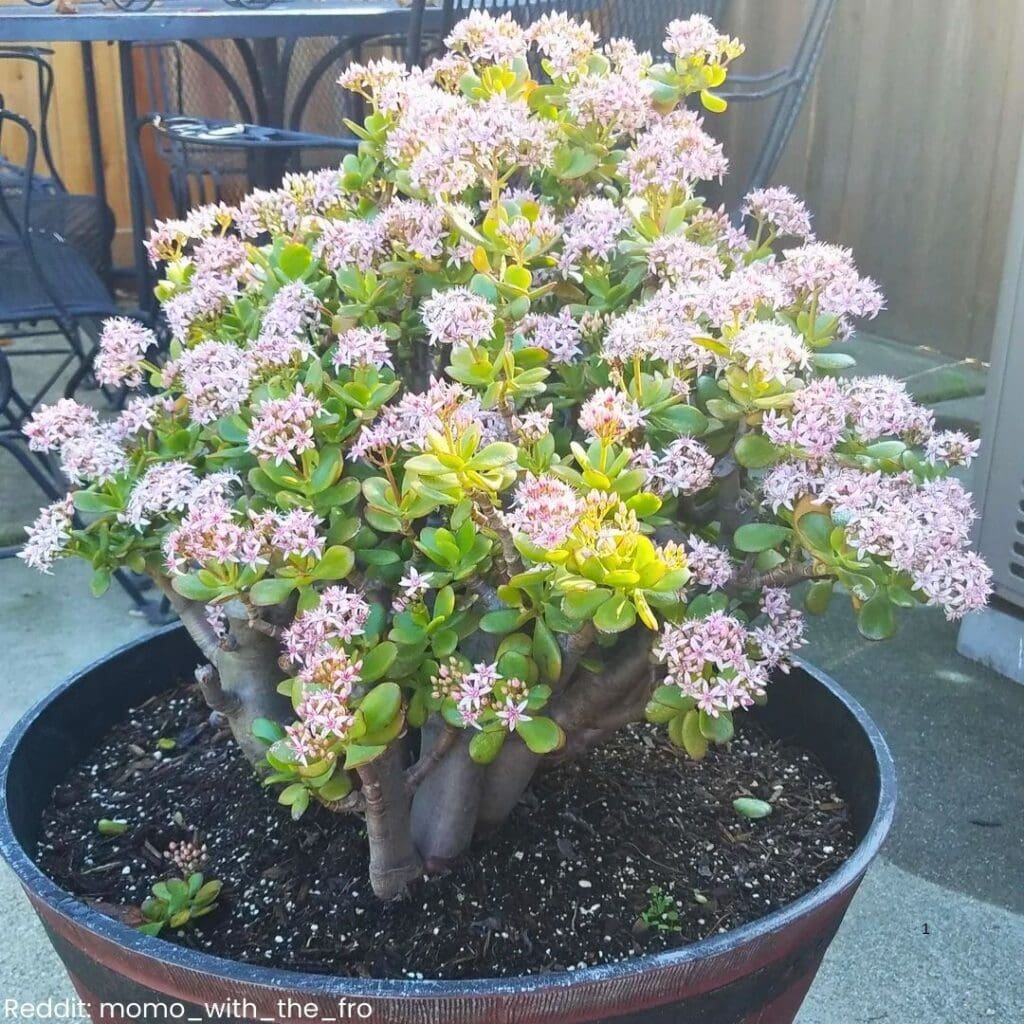
Please note: Simplify Plants is reader-supported. As an Amazon Associate, I earn from qualifying purchases made by our readers with no extra cost added to you all! Some links in the post are affiliate links and I get a commission from purchases made through links in the post.
1) Ensure adequate sunlight
I’ve found that jade plants need lots of bright light to produce their beautiful flowers. My most successful blooming jade plants get at least 4-6 hours of direct sunlight each day.
The best spot for your jade plant is near a south-facing window. I place mine where it can soak up the morning sun, which helps trigger blooming while avoiding the harsh afternoon rays.
If your jade plant stretches or leans toward the light, it needs more sun. I’ve noticed that the leaves turn slightly red at the edges when they get enough light – this is a good sign!
In winter, I move my jade plant closer to the window since the sun is weaker. Good lighting during winter months is extra important for getting your jade to bloom in spring.
If you can’t provide enough natural light, try using a grow light. I set mine about 6 inches above the plant and keep it on for 12-14 hours daily.
The right amount of sun also helps keep your jade plant compact and bushy. I rotate my pot every few weeks so all sides get equal light exposure.
2) Water moderately
I find that jade plants need careful watering to produce their beautiful blooms. Too much water will stop them from flowering and could even harm the plant.
I recommend waiting until the top inch of soil feels dry before watering again. This usually means watering once every 7-10 days during growing season.
In winter, I cut back watering to about once every 2-3 weeks. The soil should dry out more between waterings during cold months when the plant is semi-dormant.
The key is to avoid overwatering. I check the soil moisture with my finger – if it feels even slightly damp, I wait another day or two before watering.
I make sure my jade plant’s pot has drainage holes and never let it sit in standing water. Good drainage prevents root rot and encourages those lovely star-shaped flowers.
The plant tells me when it needs water – the leaves get a bit soft and wrinkled. But I’m careful not to wait too long, as very dry soil can stress the plant and reduce blooming.
3) Use a well-draining soil mix
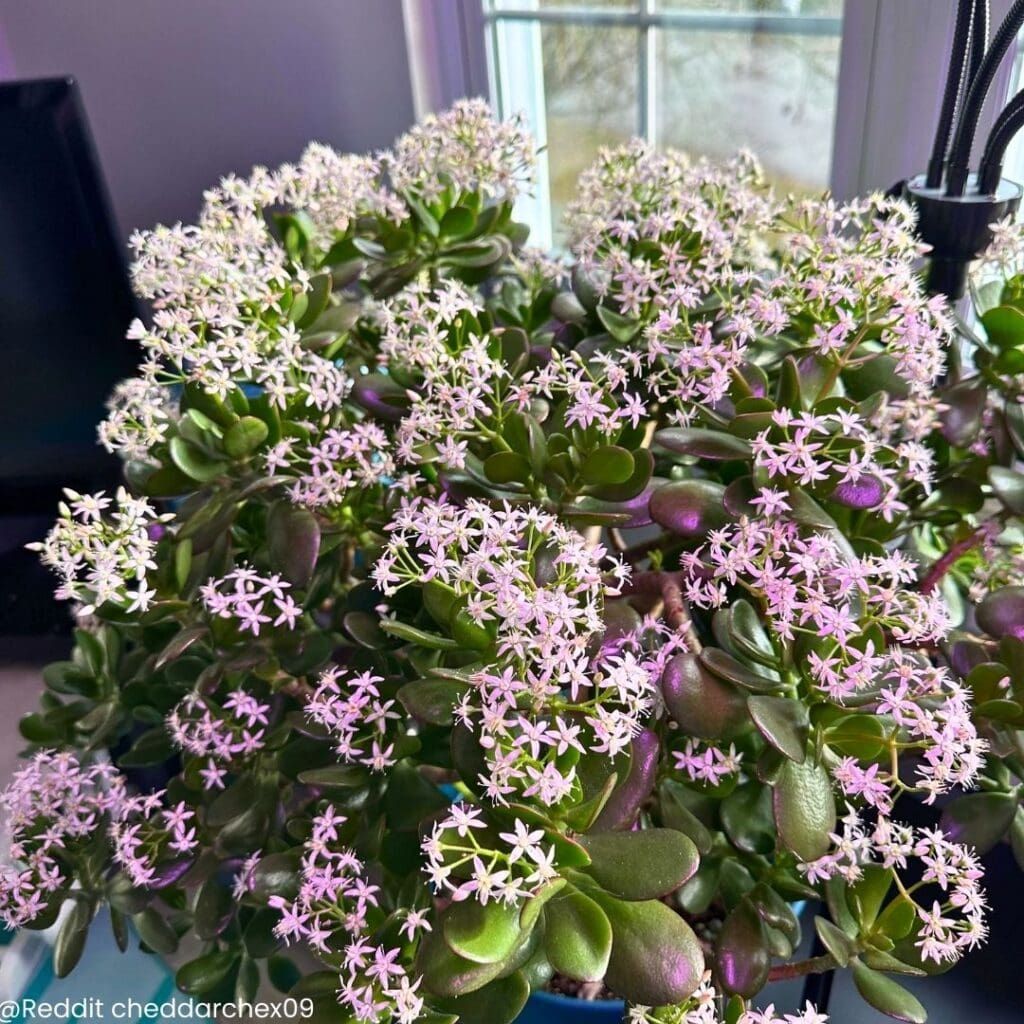
I recommend creating a special soil mix for your jade plant to help it bloom. The right soil mix is crucial for healthy jade plants and flower production.
A good mix should be about 50% regular potting soil and 50% perlite or coarse sand. This combo helps water flow through easily and stops root rot.
Never use garden soil or heavy potting mixes for jade plants. These hold too much water and can damage the roots. I’ve found that adding small rocks or gravel at the bottom of the pot also helps with drainage.
I like to mix in some crushed eggshells or a bit of bone meal. These add calcium that helps make the stems strong and supports flower growth.
When I repot my jade plant, I make sure the new pot has drainage holes. Even the best soil mix won’t work well if water can’t escape from the bottom.
Your jade plant will show you if the soil mix is right. Healthy leaves and firm stems are signs that the drainage is good. If leaves start falling off or feel soft, the mix might be too wet.
4) Apply a balanced fertilizer
I recommend using a balanced NPK fertilizer with equal parts nitrogen, phosphorus, and potassium to help your jade plant bloom. A 10-10-10 fertilizer works great for this purpose.
During the growing season (spring and summer), I feed my jade plant once a month. I make sure to dilute the fertilizer to half strength to avoid burning the roots.
I always stop fertilizing in fall and winter. This rest period helps trigger blooming, since jade plants need some stress to produce flowers.
Never fertilize a dry plant. I water my jade thoroughly first, then apply the fertilizer solution. This helps prevent root damage and ensures better nutrient absorption.
I’ve found that liquid fertilizers are easier to use than granular ones. They dissolve quickly and provide more even coverage for the roots.
If you notice yellow leaves, you might be using too much fertilizer. I scale back the amount or frequency when this happens. A little goes a long way with jade plants.
5) Prune to encourage growth
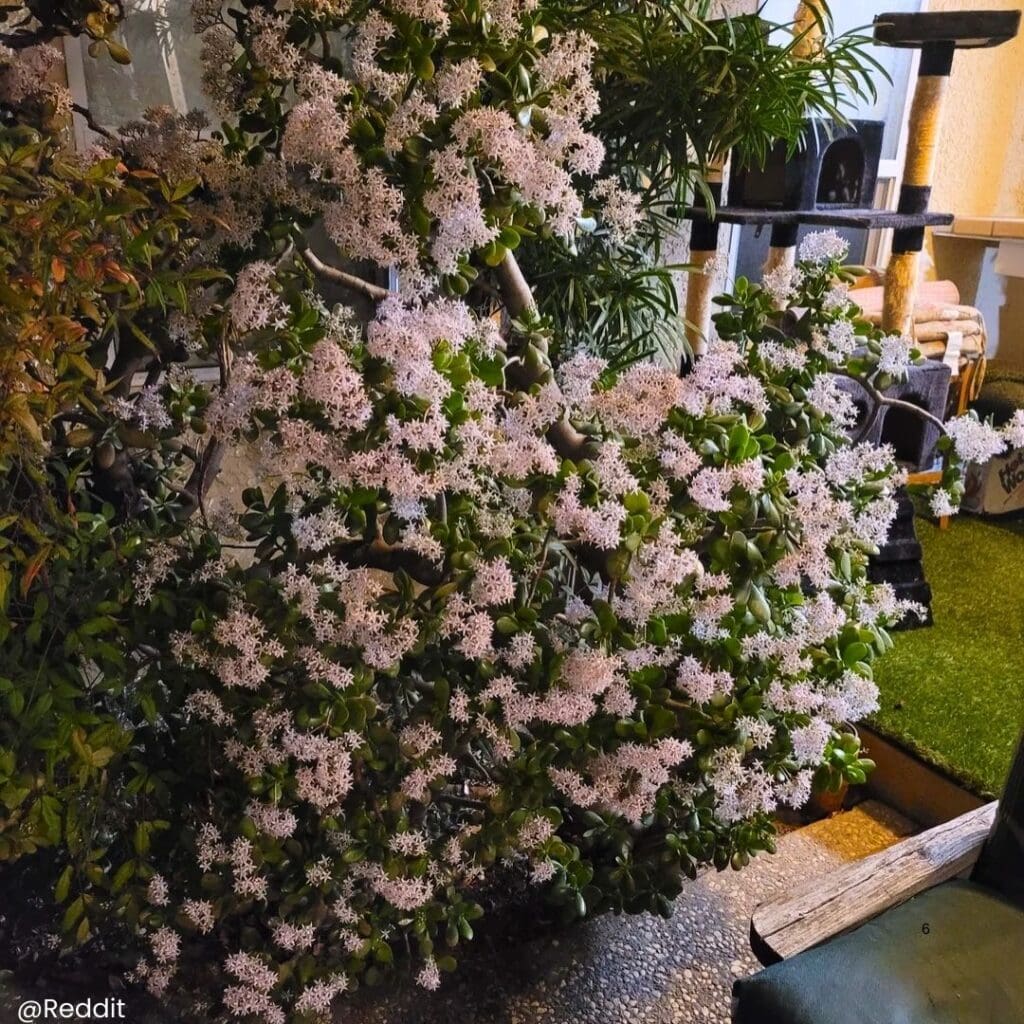
I recommend pruning your jade plant regularly to help it bloom. When you cut back the stems and branches, it signals the plant to create new growth and eventually produce flowers.
Spring and summer are the best times to prune your jade plant. I like to use clean, sharp scissors or pruning shears to make precise cuts just above a leaf node.
You can safely remove up to 25% of the plant’s branches during each pruning session. I focus on cutting back leggy stems and removing any dead, damaged, or crossing branches.
Don’t throw away those pruned pieces! You can propagate them to create new jade plants. I simply let the cut ends dry for a few days, then plant them in well-draining soil.
After pruning, I notice my jade plant becomes fuller and more compact. This denser growth pattern creates more potential spots for flowers to develop in the future.
Remember to clean your pruning tools with rubbing alcohol between cuts. This helps prevent the spread of any potential plant diseases and ensures healthy growth.
6) Repot if root-bound
I’ve noticed that root-bound jade plants rarely bloom. When roots get too crowded in the pot, the plant focuses on survival instead of making flowers.
Check your jade plant’s roots every spring. I gently slide the plant out of its pot to look. If I see roots wrapped tightly around each other or growing out of drainage holes, it’s time to repot.
I like to move my jade plant to a container that’s 1-2 inches wider than the current one. The new pot needs drainage holes and fresh succulent soil mix. This gives roots space to grow.
Spring is the perfect time to repot jade plants. I make sure to wait a week after repotting before watering. This lets any damaged roots heal and helps prevent rot.
Once repotted, my jade plant has more energy to make flowers instead of dealing with cramped roots. The fresh soil also gives it extra nutrients it needs for blooming.
7) Maintain warm temperatures
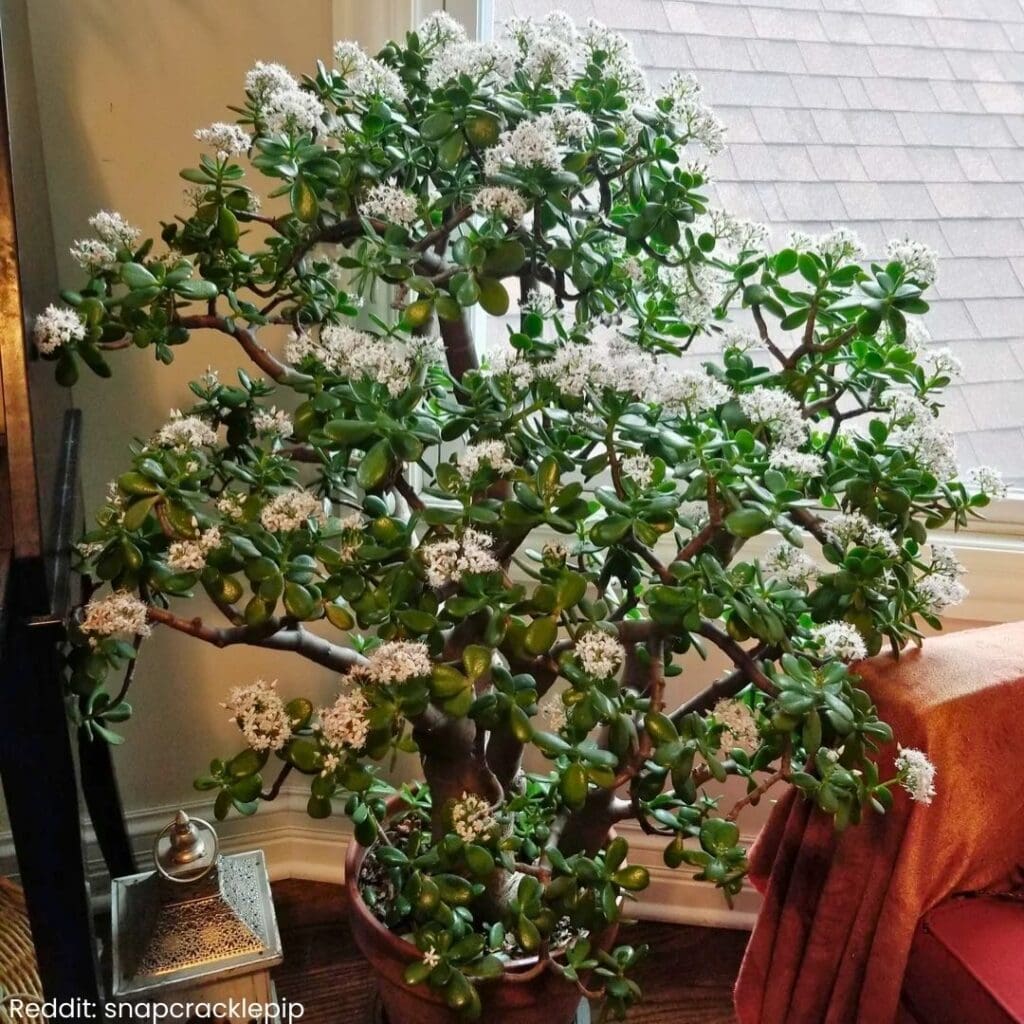
I recommend keeping your jade plant in warm temperatures between 65-75°F (18-24°C) during the day. These temps match their natural habitat and encourage blooming.
At night, I suggest letting the temperature drop about 10 degrees. This temperature change from day to night helps trigger the blooming process in jade plants.
Avoid cold drafts from windows, doors, or air conditioning vents. My jade plants always do better when I keep them away from these spots. Cold air can damage the leaves and prevent flowering.
I’ve found that placing jade plants in rooms that stay consistently warm works best. Good spots include living rooms and bedrooms that maintain steady temperatures throughout the day.
If you live in a cold climate, I recommend moving your jade plant away from windows during winter. The cold glass can create a chilly microclimate that stops blooms from forming.
During summer, I make sure my jade plants don’t get too hot. Temperatures above 80°F (27°C) can stress the plant and reduce flowering chances.
8) Increase humidity
I recommend misting your jade plant with water once or twice a week. Regular misting helps create the humid environment these plants need to produce flowers.
You can also place a humidity tray near your jade plant. Just fill a shallow tray with pebbles and water, then set it close to the plant. The water will slowly evaporate and increase moisture in the air.
Grouping plants together is another great way to boost humidity. I like to place my jade plant near other houseplants since they naturally release water vapor through their leaves.
If you live in a very dry climate, consider using a small humidifier. I place mine about 3 feet away from my jade plant to avoid making the soil too wet.
Be careful not to overdo the humidity. Too much moisture can lead to fungal issues. I aim to keep humidity levels between 40-50% for my jade plants.
During winter months, I reduce misting since jade plants enter a rest period. This matches their natural growth cycle and helps trigger blooming when spring arrives.
9) Check for pests regularly
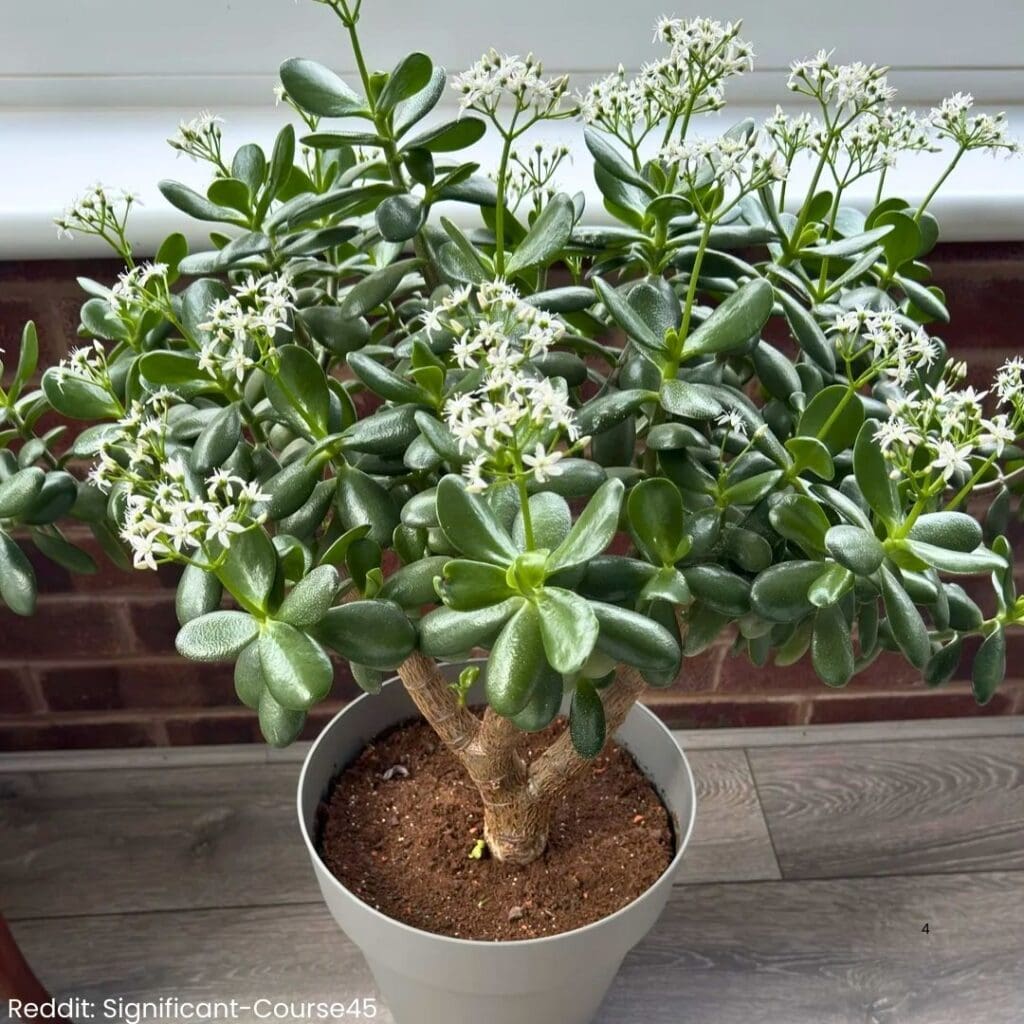
I recommend checking your jade plant for pests at least once a week. Regular pest inspections help catch problems early before they harm your plant’s ability to bloom.
The most common pests I see on jade plants are mealybugs and spider mites. These tiny bugs like to hide under leaves and in stem joints where they can be hard to spot.
I use a magnifying glass to look closely at my plant’s leaves and stems. This helps me find even the smallest pest problems before they spread.
When I find pests, I remove them by wiping the leaves with rubbing alcohol on a cotton swab. For bigger problems, I spray my jade plant with insecticidal soap or neem oil.
Healthy plants resist pests better than stressed ones. I keep my jade plant strong by giving it proper light, water, and nutrients. This makes it less likely to get pest problems that could stop it from blooming.
I also isolate any new plants for 2 weeks before putting them near my jade plant. This stops pests from spreading from new plants to my existing ones.
10) Provide adequate airflow
I’ve found that good air circulation helps jade plants bloom better. A gentle breeze strengthens the stems and creates the right conditions for flower buds to form.
I place my jade plant near an open window or use a small fan to create light air movement. The fan should be set on low – just enough to make the leaves flutter slightly.
Indoor spaces can get stuffy, which isn’t ideal for jade plants. Moving air prevents moisture from sitting on the leaves too long and reduces the risk of fungal problems.
I make sure not to put my jade plant in direct line of a heating or air conditioning vent. These create harsh conditions that can stress the plant and prevent blooming.
Regular pruning helps with airflow too. I remove any dead or crowded branches so air can move freely through all parts of the plant.
In winter, I’m extra careful about air movement. Cold drafts can harm jade plants, so I keep them away from drafty windows while still maintaining gentle air circulation.
Using a fan or opening windows for a few hours each day has made a big difference in my jade plant’s health. The stems grow stronger and the plant seems more likely to produce those pretty white or pink flowers.
Ideal Growing Conditions

I’ve found that jade plants need specific conditions to produce their lovely star-shaped flowers. Bright sunlight is essential – I place my jade plant where it gets at least 4-6 hours of direct sun each day.
Temperature plays a big role in blooming. I keep my jade plant at 65-75°F (18-24°C) during the day and slightly cooler at night, around 55°F (13°C).
The soil must drain well to prevent root rot. I use a mix made for succulents, or I create my own by combining regular potting soil with sand and perlite.
Water needs change with seasons. During spring and summer, I water when the top inch of soil feels dry. In fall and winter, I cut back watering to once every 2-3 weeks.
Here’s what my jade plant needs to thrive:
- Full sun exposure
- Low humidity
- Well-draining soil
- Limited water in winter
- Regular feeding in growing season
I’ve noticed that mature plants bloom better than young ones. My jade plants usually need to be at least 4-5 years old before they start flowering.
Tight quarters help blooming. I keep my jade plant slightly root-bound in its pot and avoid repotting too often.
Encouraging Blooms
Jade plants need very specific conditions to produce their lovely white or pink star-shaped flowers. I’ve found that proper light and careful watering make the biggest difference.
Optimal Lighting
I always place my jade plants in spots that get at least 4-6 hours of direct sunlight each day. The best location is near a south-facing window.
During winter months, I move them even closer to the windows since light levels drop. Strong light exposure helps trigger blooming.
I’ve noticed my jade plants bloom best when I give them a period of cold nighttime temperatures around 55°F (13°C) in fall and winter. This temperature drop signals them to produce flower buds.
Watering Techniques
I water my jade plants deeply but less frequently during their blooming season. This mimics their natural desert environment.
In fall and winter, I cut back watering to about once every 2-3 weeks. Slight drought stress can actually encourage flowering.
I always check that the soil is completely dry before watering again. My rule of thumb is to stick my finger an inch into the soil – if it feels even slightly damp, I wait another day or two.
Root rot will prevent blooming, so I make sure my pots have good drainage holes and I never let water collect in the saucer.
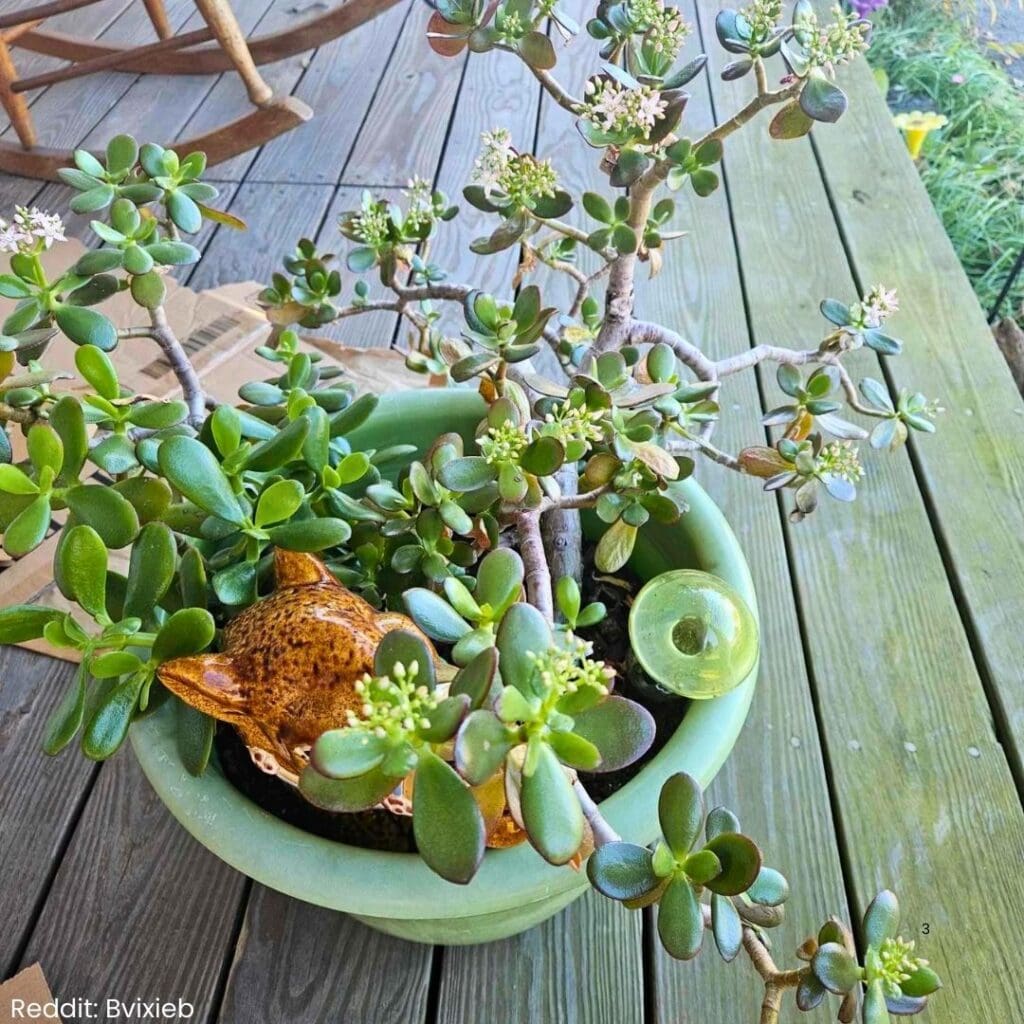
Frequently Asked Questions
Growing jade plants requires specific care techniques to encourage those lovely white or pink blooms. I’ve found that success comes down to light, water, and patience.
How can I encourage my jade plant to flower?
I recommend placing your jade plant in a spot that gets at least 6 hours of direct sunlight daily. Keep the soil slightly dry between waterings – this mild stress can trigger blooming.
Make sure your pot has drainage holes and use a cactus potting mix. Too much water will prevent flowering and might harm your plant.
What are the ideal conditions for a jade plant to bloom?
The perfect temperature range is between 65-75°F during the day and slightly cooler at night. Low humidity helps too.
Your jade plant needs a rest period in winter with less water and cooler temperatures around 55°F.
What type of fertilizer should be used for jade plants to promote flowering?
I use a balanced 10-10-10 fertilizer during the growing season, from spring to early fall. Apply it once every 2-3 months.
Don’t fertilize in winter – your plant needs this rest period to prepare for blooming.
How often do jade plants typically bloom?
Mature jade plants usually bloom once per year. Your plant needs to be at least 4-6 years old before it will flower.
Some plants might skip blooming some years, and that’s normal.
Is there a specific season when jade plants are more likely to bloom?
Most jade plants bloom in late winter to early spring. This typically happens between January and March.
The shorter days of winter help trigger the blooming cycle.
Can using coffee grounds help my jade plant produce flowers?
I don’t recommend using coffee grounds. They can make the soil too acidic and might harm your plant.
Stick to proper jade plant fertilizer for the best results.
Recommended Garden Supplies
| Product Image | Our Recommended Gardening Supplies | Check Offers! |
|---|---|---|
Top Top
Top
Top
Top
Top
Top
Top
Top | rePotme Houseplant and Tropical Classic Potting Soil Mix | Check Offer On Amazon |
 Top
Top
Top
Top
Top
Top
Top
Top | Espoma Organic Indoor Plant Food | Check Offer On Amazon |
 Top
Top
Top
Top
Top
Top
Top
Top | GooingTop LED Grow Light 6000K Full Spectrum Clip Plant Growing Lamp | Check Offer On Amazon |
 Top
Top
Top
Top
Top
Top
Top
Top | Soil Moisture Meter | Check Offer On Amazon |
 Top
Top
Top
Top
Top
Top
Top
Top | Govee Hygrometer Thermometer, Bluetooth Enabled! | Check Offer On Amazon |
 Top
Top | LEVOIT Humidifiers for Large Room(Best For Plants) | Check Offer On Amazon |
 Top
Top
Top
Top
Top
Top
Top
Top | Upgraded DIY Automatic Drip Irrigation Kit, 15 Potted Houseplants Support | Check Offer On Amazon |
 Top
Top
Top
Top
Top
Top
Top
Top | Stainless Steel Heavy Duty Gardening Tool Set | Check Offer On Amazon |
 Top
Top
Top
Top
Top
Top
Top
Top | Bonide Insecticidal Soap | Check Offer On Amazon |
 Top
Top
Top
Top
Top
Top
Top
Top | Bonide 32 oz Spray Neem Oil for Organic Gardening | Check Offer On Amazon |
 Top
Top
Top
Top
Top
Top
Top
Top | Garden Safe Fungicide | Check Offer On Amazon |



